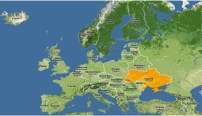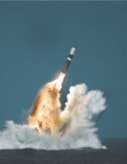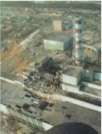February 20th, 2014

According to a report by the New York Times on February 19, 2014: “Ukrainian anti-government protesters mount a final desperate and seemingly doomed act of defiance in Kiev, establishing a protective ring of fire around what remains of their all-but-conquered encampment on Independence Square; police report at least 14 people killed in worst day of violence in more than two months of protests against Pres Viktor F Yanukovyc.” With Ukraine in the news, we thought it would be helpful to share some facts about this Eastern European country.
Background: Ukraine was the center of the first eastern Slavic state, Kyivan Rus, which during the 10th and 11th centuries was the largest and most powerful state in Europe. During the latter part of the 18th century, most Ukrainian ethnographic territory was absorbed by the Russian Empire. Following the collapse of czarist Russia in 1917, Ukraine was able to achieve a short-lived period of independence (1917-20), but was reconquered and forced to endure a brutal Soviet rule that engineered two forced famines (1921-22 and 1932-33) in which over 8 million died. In World War II, German and Soviet armies were responsible for some 7 to 8 million more deaths. Although final independence for Ukraine was achieved in 1991 with the dissolution of the USSR, democracy and prosperity has remained elusive as the legacy of state control and endemic corruption stalled efforts at economic reform, privatization, and civil liberties. A peaceful mass protest “Orange Revolution” in the closing months of 2004 forced the authorities to overturn a rigged presidential election and to allow a new internationally monitored vote that swept into power a reformist slate under Viktor YUSHCHENKO. Subsequent internal squabbles in the YUSHCHENKO camp allowed his rival Viktor YANUKOVYCH to stage a comeback in parliamentary elections and become prime minister in August of 2006. An early legislative election, brought on by a political crisis in the spring of 2007, saw Yuliya TYMOSHENKO, as head of an “Orange” coalition, installed as a new prime minister in December 2007. Viktor YANUKOVUYCH was elected president in a February 2010 run-off election that observers assessed as meeting most international standards. The following month, Ukraine’s parliament, the Rada, approved a vote of no-confidence prompting Yuliya TYMOSHENKO to resign from her post as prime minister. In October 2012, Ukraine held Rada elections, widely criticized by Western observers as flawed due to use of government resources to favor ruling party candidates, interference with media access, and harassment of opposition candidates.
Source: https://www.cia.gov/library/publications/the-world-factbook/geos/up.html

1. Ukraine is the largest state in Europe (slightly smaller than Texas). It has an area of 603,628 sq km and borders the Black Sea.
2. The government of Ukraine is a Republic.
3. Ukrainian is the official language of Ukraine. Russian is spoken in eastern and southern parts of the country
4. Kiev is the capital city of Ukraine with a population of 2,797,553 and covering an area of 323.9 square miles, it is the largest city of Ukraine. Kiev is the industrial, scientific, educational and cultural center of Eastern Europe. There are many high-tech industries, colleges and universities, and world-famous historical landmarks in Kiev.
5. Ukraine was the land for Trypillian Civilization, one of the world’s most ancient civilizations. Neolithic archeological culture which existed between 5500 BC and 2750 BC on the territory of modern Ukraine.
6. More than half the population of Ukraine is constituted by ethnic Ukrainians. The other ethnic groups in the country include Russians, Belarusians, Moldovans, Crimean Tatars, Bulgarians, Hungarians, Romanians, Jews, Armenians, Poles, Greeks and Tatars.

7. Arsenalnaya Metro Station located in Kiev is the deepest in the world (105 meters/344.488 feet). The station was built in1960 and is close to the House of Parliament. It is said that the tunnels near Arsenalnaya have secret shelters built for the political elite.

8.The National University of Ostroh Academy, founded in 1576 by the Prince Vasyl-Kostiantyn of Ostroh, is the first university in Eastern Europe. It is the successor of Ostroh Slavic, Greek and Latin Academy, the first higher educational establishment of the Eastern Slavs.

9. Ukraine is the 4th educated nation in the world. 99.4% literacy in Ukrainians aged 15 and over. 70% of adult Ukrainians have secondary or higher education. The country has about 150 colleges and universities and 80 research institutes.
10. Orthodox Christianity is the dominant religion in Ukraine. The other Christian denominations include Roman Catholicism and Protestantism. Small communities of Calvinists, Jehovah’s Witnesses, Lutherans, Methodists and Seventh-day Adventists, and the Church of Jesus Christ of Latter-day Saints are also found. Judaism and Islam are also practiced.

11. In 1710, Ukrainian Hetman Pylyp Orlyk introduced “Pacts and Constitutions of Rights and Freedoms of the Zaporishiah Host,” considered by some researchers as one of the world’s first constitutions. This was, at the time, a progressive document which asked for separation of powers of government into three branches and regulation of the rights and responsibilities of the government and citizens

12. The An-255 “Mriya” was invented by Ukrainians and is considered to be the largest freight-carrying plane in the world. It was originally designed for spacecraft transportation, but now is used in freight haulage.
13. “Summertime,” one of the world’s most famous songs written by George Gershwin was inspired by an old Ukrainian lullaby “Oi Khodyt Son Kolo Vikon” (The Dream Passes by the Windows). Gershwin’s parents were from Odessa, Ukraine.

14. When Ukraine declared its independence from the USSR, it had over a thousand nuclear warheads and the third largest nuclear potential after Russia and America. On its own initiative, Ukraine refused to hold onto the third largest arsenal of nuclear weapons in the world and handed the warheads and missiles over to Russia and destroyed the silos. In return, Ukraine was compensated financially for disarmament and guaranteed security from other the nuclear powers.

15. The Chernobyl disaster was a catastrophic nuclear accident that occurred on April 26, 1986 at the Chernobyl Nuclear Power Plant in Ukraine (then officially the Ukrainian SSR), which was under the direct jurisdictions of the central authorities of the Soviet Union. An explosion and fire released large quantities of radioactive particles into the atmosphere, which spread over much of the west USSR and Europe.

16. According to a Research and Branding Group Survey, a large percentage of Ukrainians, nearly 80%, have never travelled abroad.

17. Ukrainians wear their wedding ring on the ring finger of their right hand instead of the left hand.

18. As of 201, Ukraine is the third largest exporter of grain in the world.
19. The third most visited McDonald’s in the world is located in Kiev, near the train station, and considered to be in the top five most crowded McDonald’s in the world.
20. Every year, on August 24, Ukrainians celebrate their Independence day also known as national day. The day marks the declaration of Ukraine from the Soviet Union on the 24th of August, 1991.

Academic Credentials Evaluation Institute, Inc.
www.acei1.com


